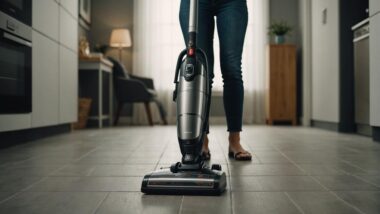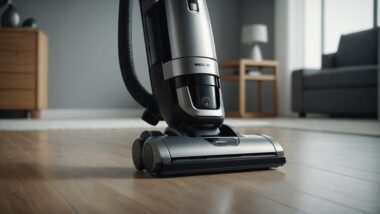Miele Stick Vacuum Vs Dyson
When choosing between a Miele Stick Vacuum Vs Dyson, you’re not just deciding on a cleaning tool, but investing in a design philosophy.
Miele prioritizes suction power and durability with its high-end bagged models, while Dyson emphasizes cost-effectiveness and convenience with its bagless vacuums.
Corded models provide consistent power, while upright models offer advanced features.
Cordless models cater to different needs, with Dyson’s V-Series offering high performance and Miele’s Triflex HX1 providing versatility.
By understanding the key differences, you’ll make an informed decision.
Now, take a closer look at the specifications and features that matter most to you.
Key Takeaways
- Miele prioritizes suction power and durability in its bagged stick vacuums, while Dyson focuses on cost-effectiveness in its bagless models.
- Corded stick vacuums from Miele offer consistent power and suction, ideal for heavy-duty cleaning, whereas upright models from Dyson feature advanced filtration systems.
- Dyson’s V-Series cordless vacuums boast high performance, automatic power adjustment, and longer battery life, making them suitable for heavy-duty tasks.
- Miele’s Triflex HX1 cordless vacuum offers a unique three-in-one design, providing versatility and compactness, ideal for those valuing flexibility and ease of use.
- When choosing between Miele vs Dyson, consider your cleaning needs and habits, weighing suction power, battery life, and design philosophy to make an informed decision.
Design Philosophy and Vacuum Types
When choosing between Miele vs Dyson stick vacuums, understanding their distinct design philosophies and vacuum types is crucial, as it greatly influences the features and benefits you can expect from your cleaning experience.
Miele specializes in high-end bagged models, known for their superior suction performance and durability.
On the other hand, Dyson focuses on bagless vacuums, offering lower ownership costs but requiring more frequent filter cleaning and less hygienic dustbin emptying.
As you consider your options, it’s essential to weigh the pros and cons of each design philosophy.
If you prioritize convenience and cost-effectiveness, Dyson’s bagless vacuums might be the way to go.
However, if you’re willing to invest in a premium product with exceptional suction power and durability, Miele’s bagged models are worth exploring.
Notably, Miele has also ventured into bagless vacuums, but their core focus remains on high-end bagged models.
Corded and Upright Models Compared
As you consider Miele’s corded options, you’ll notice they offer a range of stick vacuums with varying power levels and features.
Meanwhile, Dyson’s upright models are known for their powerful suction and advanced filtration systems.
You’ll want to weigh the benefits of each type of vacuum to determine which best fits your cleaning needs and preferences.
Miele Corded Options
Miele’s corded options, including both stick and upright models, offer a unique blend of power, precision, and versatility that sets them apart from their cordless counterparts.
When comparing Miele cordless vacuums, like the Miele Triflex HX, to their corded options, you’ll notice that the latter provides more consistent power and suction.
This makes them ideal for tackling heavy-duty cleaning tasks, such as deep-cleaning carpets or tackling pet hair.
Additionally, Miele’s corded stick vacs often come with more advanced features, like adjustable suction control and variable speed settings, which give you more precision and control over your cleaning.
While cordless vacuums offer convenience, Miele’s corded options provide the reliability and performance you need for thorough, everyday cleaning.
When weighing the benefits of Miele vacuums vs Dysons, consider your cleaning needs and preferences. If you prioritize power and precision, Miele’s corded options might be the better choice for you.
Dyson Upright Performance
Dyson’s upright models, both corded and cordless, offer impressive performance and features.
The Dyson Ball Animal 3, in particular, boasts a powerful digital motor that captures allergens and small particles, making it a great option for households with pets or allergies.
Its self-adjusting cleaner head seals in suction across all floor types, including hard floors, and is easy to maneuver.
While the Dyson Cinetic Big Ball is a reliable corded upright option, it can’t quite match the quality and performance of Miele’s offerings.
However, Dyson upright models are generally more affordable, with prices ranging from around $400 to $600, making them a more budget-friendly option.
Cordless Models and Their Features
When it comes to cordless stick vacuums, two market leaders stand out: Dyson’s V-Series and Miele’s Triflex HX1, each boasting unique features that cater to different cleaning needs and preferences.
As you explore these options, you’ll notice Dyson’s V-Series cordless vacuums are known for their sleek design and high performance, featuring a powerful suction motor and automatic power adjustment in the flagship V15 Detect model.
This model also comes with a built-in piezo sensor that counts and measures debris size, displaying the information on an LED screen.
In contrast, the Miele Triflex HX1 has a unique three-in-one design, allowing you to rearrange the motor unit, grip, wand, and floorhead for different configurations.
While both brands offer cordless models with impressive features, Dyson’s V-Series generally has better suction power and longer battery life, making them more suitable for heavy-duty cleaning tasks.
However, the Miele Triflex HX1’s versatility and compact design make it an attractive option for those who value flexibility and ease of use.
Specifications and Performance Metrics
Delving into the specifications and performance metrics of these cordless stick vacuums.
We find that suction power, dustbin capacity, runtime, and weight are key areas where the Dyson V-Series and Miele Triflex HX1 differ significantly.
When it comes to suction power, the Dyson V12 Detect Slim and V15 Detect boast impressive max suction levels of 6.1 inH2O and 9.8 inH2O, respectively. In contrast, the Miele Triflex HX1 lags behind with a max suction of 1.7 inH2O.
The Miele Triflex HX1 has a slightly larger dustbin capacity of 0.07 gal compared to the Dyson V12 Detect Slim’s 0.04 gal.
When it comes to runtime, the Dyson V12 Detect Slim offers a range of 8.2-70 minutes, while the Miele Triflex HX1 falls short with a runtime of 18-34 minutes.
You’ll also notice a significant difference in weight, with the Miele Triflex HX1 weighing 8.18 lbs, nearly 3 lbs more than the Dyson V12 Detect Slim.
As you consider these metrics, think about what matters most to you in a cordless vacuum cleaner. Are you prioritizing suction power, dustbin capacity, or runtime?
Brand Comparison and Additional Information
Your decision between the Miele Triflex HX1 and Dyson V-Series ultimately comes down to the values and priorities each brand embodies, particularly when it comes to design, filtration, and customer support.
Miele and Dyson vacuums have distinct design languages, with Miele’s focus on sleek, modern lines and Dyson’s emphasis on innovative, futuristic aesthetics.
The Ball technology in Dyson’s cordless vacuums provides better maneuverability, but Miele’s models offer a more full range of attachments.
When it comes to filtration, Miele is known for its superior HEPA filters, capturing 99.99% of particles as small as 0.3 microns.
Dyson, on the other hand, has made significant strides in improving its filtration systems in recent models.
Both brands offer excellent customer support, but Miele’s reputation for durability and reliability might give it an edge.
Ultimately, one brand may be a better fit for you depending on your cleaning needs and preferences.
Key Differences and Buying Decision
With your priorities and values in mind, the key differences between the Miele Triflex HX1 and Dyson V-Series come into sharp focus, making it essential to weigh their distinct strengths and weaknesses to make an informed buying decision.
If you prioritize suction power and battery life, Dyson’s cordless stick vacuums might be the better choice for you. They offer longer battery life and more advanced features, but at a higher price point.
On the other hand, if you value versatility and a unique design, Miele’s stick vacuum is ideal.
Its three-in-one design allows for rearrangement of the motor unit, grip, wand, and floorhead for different configurations.
However, it has a smaller dirt compartment that needs emptying more frequently. Consider your cleaning needs and habits: do you need a vacuum with strong suction power or one that’s adaptable to different spaces?
Conclusion
You’ve weighed the pros and cons of Miele stick vacuums versus Dyson – now it’s time to make a decision.
Remember, ‘the grass is always greener where you water it,’ so choose the brand that best fits your cleaning needs and lifestyle.
If you prioritize powerful suction and advanced filtration, Miele might be the way to go.
But if you prefer sleek designs and innovative technology, Dyson could be the perfect fit.
Whatever you choose, rest assured you’ll be getting a high-quality stick vacuum that’ll make your cleaning routine a breeze.

